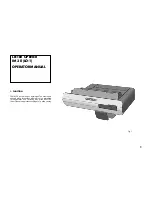
TECHNICAL SPECIFICATION
29
D-0014930-A
– Otowave 102-C Operating Manual
15.
TECHNICAL SPECIFICATION
15.1.
PERFORMANCE
Tympanometry
Instrument type
Meatus compensated tympanometer
Analysis performed
Compliance peak level (in ml) & pressure; Gradient (in
daPa);
Ear Canal Volume (ECV) @ 200 daPa
Probe tone levels and accuracy
226Hz +/- 2%; 85dB SPL +/-2dB over range 0.2ml to 5ml
Pressure levels and accuracy
+200daPa to -4/-10daPa or +/-10% (whichever
is larger) over range
Ear volume measurement range and
accuracy
0.2ml to 5ml +/- 0.1ml or +/-5% (whichever is larger) over
entire range
Sweep speed
Typically 200-300daPa/sec; dependent on ear/cavity
volume
Pressure limits (safety cutout)
+600 to -800 daPa
Number of samples stored
100 per tympanogram
Reflex measurements
Measurement mode
Ipsilateral
Reflex tone levels and accuracy
500Hz,1kHz,2kHz,4kHz (+/-2%)
Configurable over range 70dB to100dBHL (4kHz
restricted to 95dBHL) +/-3dB, referenced to 2cc
calibration volume; Compensates for measured ear
volume
Number of reflex levels
Four: 100dB with 5dB or 10 dB steps; 95dB, 90dB or
85dB with 5 dB steps
Reflex analysis
Reflex pass/fail at each level tested; maximum amplitude
of each reflex; nominal pressure used for the reflex test
(computer display only)
Pressure used for reflex measurement
Pressure at tympanogram peak, or at 0daPa (if no peak
found)
Reflex stimulus control
Stimulus presented at all levels, or
stimulus ceases when a reflex is found
Reflex detection threshold and accuracy
0.01ml to 0.5ml +/-0.01ml (configurable in 0.01ml steps)
Reflex tone duration
0.6 seconds
Data Management
Number of records stored in Patient
Database
32
Data storage
Any recording can be stored once the tympanogram is
viewed. Patient Initials (A-Z, 0-
9, “-“) must be entered
before storage.
Data held
Patient Initials, Tympanogram and Reflex graphs and
analysis for Left Ear and/or Right Ear, Time and Date of
recording, which ears were tested, whether or not the
record has been printed and/or sent to a computer,
parameters used for analysis, 128 bit Globally Unique
Identifier (GUID)
Display mode
Records listed in reverse chronological order (latest first),
with indication of data stored as described above
Real Time Clock
Time stamps
Time and date stamp applied to all recordings, and to the
last calibration date












































